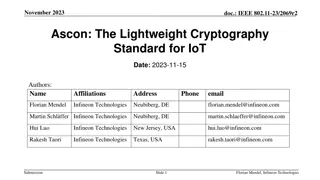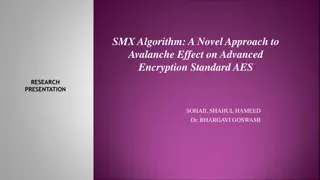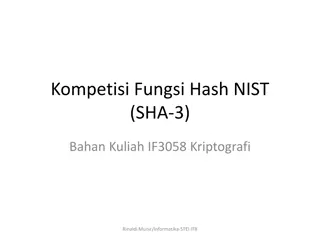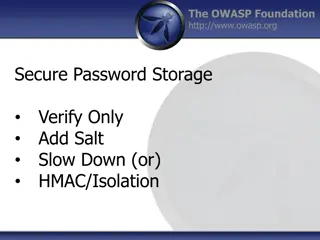Understanding SHA-256 Algorithm and History
"SHA-256 is a secure hashing algorithm that produces 256-bit hash values and is more secure than MD5, SHA-0, and SHA-1 due to fewer collisions. Created in 2001 by the NSA, it is widely used in various applications like cryptocurrency, SSL certificates, and blockchain. This summary provides insights into the process and significance of SHA-256."
Download Presentation

Please find below an Image/Link to download the presentation.
The content on the website is provided AS IS for your information and personal use only. It may not be sold, licensed, or shared on other websites without obtaining consent from the author. Download presentation by click this link. If you encounter any issues during the download, it is possible that the publisher has removed the file from their server.
E N D
Presentation Transcript
SHA-256 Daniel Whitaker
History of SHA-256 SHA-256 stands for Secure Hashing Algorithm, produces 256 bit hash Part of the SHA-2 family of algorithms, created in 2001 by the NSA More secure than MD5, SHA-0, and SHA-1 More secure as these algorithms have documented collisions A collision is when two distinct inputs map to the same output Used in cryptocurrency, Secure Sockets Layer (SSL) Certificates, and Blockchain
Example Phase 1 Let us walk through the SHA-256 algorithm using password as the input 2. Pad the input until the length is a multiple of 512 (minus 64 bits) a. After we pad, our input is 448 bits 01110000 01100001 01110011 01110011 01110111 01101111 01110010 01100100 10000000 00000000 00000000 00000000 00000000 00000000 00000000 00000000 00000000 00000000 00000000 00000000 00000000 00000000 00000000 00000000 00000000 00000000 00000000 00000000 00000000 00000000 00000000 00000000 00000000 00000000 00000000 00000000 00000000 00000000 00000000 00000000 00000000 00000000 00000000 00000000 00000000 00000000 00000000 00000000 00000000 00000000 00000000 00000000 00000000 00000000 00000000 00000000 Phase 1: Pre Phase 1: Pre- -process the input process the input 1. Convert input to binary a. p = 112 in ASCII b. In 8 bit binary 0111000 01110000 01100001 01110011 01110011 01110111 01101111 01110010 01100100
Example Phase 1 3. For the last 64 bits, we take the original input in its binary representation and count its length in bits a. password has 64 bits b. In binary, 64 is 01000000 4. Pre-processed input, is now 512 bits 01110000 01100001 01110011 01110011 01110111 01101111 01110010 01100100 10000000 00000000 00000000 00000000 00000000 00000000 00000000 00000000 00000000 00000000 00000000 00000000 00000000 00000000 00000000 00000000 00000000 00000000 00000000 00000000 00000000 00000000 00000000 00000000 00000000 00000000 00000000 00000000 00000000 00000000 00000000 00000000 00000000 00000000 00000000 00000000 00000000 00000000 00000000 00000000 00000000 00000000 00000000 00000000 00000000 00000000 00000000 00000000 00000000 00000000 00000000 00000000 00000000 00000000 00000000 01000000 00000000 00000000 00000000 00000000 00000000 00000000 00000000 01000000
Example Phase 2 Calculating h0 Phase 2: Generate Hash Values Phase 2: Generate Hash Values 1. h0 - h7 , created by using the first 8 prime numbers a. h0 maps to 2, h1 maps to 3, etc. Each hash is created in this process: 1. 2. 3. 4. Take the square root of given prime number Take first 32 bits after the decimal Multiply the result by 2^32 Convert the result to hexadecimal
Example Phase 2 2. Generate k, an array that stores 64 hash values using the first 64 prime numbers Calculating k[0] Each hash is calculated by the following: Take the cubic root of given prime number Take first 32 bits after the decimal Multiply the result by 2^32 Convert the result to hexadecimal 1. 2. 3. 4. Review of process: Input has been pre-processed into a 512 bit number We ve generated h0 - h7 We ve generated the array k
Example Phase 3 Phase 3: 512 Phase 3: 512- -bit loop bit loop 2. Append 48 additional 32-bit words to w made up of 0 s a. w now has 64 words, each word 32 bits long 3. Perform the Modification Algorithm on w 1. For each 512-bit chunk run the following loop: a. Create a new array w by converting the 512-bit chunk into 16 32-bit words 01110000011000010111001101110011 01110111011011110111001001100100 10000000000000000000000000000000
Example Phase 3 4. Create and modify variables a-h using the Compression and Mutation Algorithm. The variables a-h will be used to generate the final hash value. Note that we re using w, which is made up of 32-bit numbers. h0 is also 32 bits in binary, 8 bits in hexadecimal a-h, 8 variables, 32 bits each, 256 bits
Example Phase 3 and Phase 4 5. Modify h0 - h7 Phase 4: Generate the final hash Phase 4: Generate the final hash 1. 2. Concatenate h0 - h7 to one 64-bit string Convert h0 - h7 to hexadecimal The SHA-256 hash of Password is: E7CF3EF4F17C3999A94F2C6F612E8A888E5B1026878E4E19398B23BD38EC221A
Parting Thoughts 300 Quadrillion (300 X 10^15) The number of SHA-256 hashes being computed per second 2015. In order to perform a collision attack, you would need to calculate 2^128 hashes. At Bitcoin s rate, it would take roughly 3.6 X 10^13 years to complete. In comparison, the known universe is only 13.7 X 10^9 years old. per second by Bitcoin as of January https://crypto.stackexchange.com/questions/47809/why-havent-any-sha-256-collisions-been-found-yet























